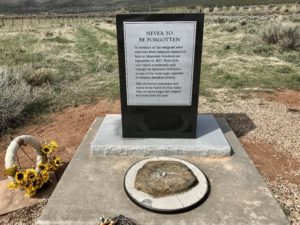Some of you may recall that last year I wrote about the Mountain Meadows Massacre. Today I visited the Mountain Meadows. I was curious to see how the commemorating of these sites is handled. This story has a lot of dark twists and turns and maybe in the end has shown the best and worst of the Mormon Church. In my opinion, this story embodies the entire reason for separation of church and state, a principle that Utah, to this day, seems to be still working on.
I stumbled on to the story after visiting the site of Lee’s Ferry, a historic crossing point of the Colorado River. John Lee was actually sent there by the church to establish a crossing to facilitate the spread of the church into Arizona and Colorado. He was the only man ever to be held culpable for what happened in the Mountain Meadows, and was executed at the site in 1877.
If you read more about this story, the dark twists and turns of the aftermath will take you through a whole range of emotions. There have been numerous books written, and the tendrils of the aftermath stretch from The Mountain Meadows, beyond Utah, to Arkansas, California, and Arizona.
Today, there are actually three commemorative sites, all of them maintained by the church. The evolution of the three sites is a story that has only been “completed” in the last few years. There is a cemetery, where some of the bodies are interred, or more accurately re-interred, and two sites established where two mass graves were eventually discovered. The latter of these are on private land, but with cooperation from the landowners they can be visited. The two are similar and are simply called the Men’s Memorial and the Women’s Memorial. The men had been separated from the women and children, so there are actually two massacre sites. The establishment of the two was largely due to the work of a California archeologist named Everett Bassett.
I give the Mormon Church credit for it’s work in establishing and maintaining the multiple sites that tell this story. And for calling a spade a spade at the sites themselves. But the path of this story, from 1859 to today, is hardly a truthful one.
“The truth doesn’t have versions, Harry!” Diane Keaton to Jack Nicholson in, Something’s Gotta Give.
